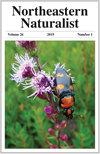阿卡迪亚国家公园冬季鸟类:缅因州海岸51年的变化
IF 0.5
4区 环境科学与生态学
Q4 BIODIVERSITY CONSERVATION
引用次数: 0
摘要
摘要-在缅因州阿卡迪亚国家公园记录鸟类观测有着悠久的历史。这些研究和由此产生的长期数据集提供了公园内部和周围发生变化的证据,也为将当地动态与区域和大陆尺度研究中检测到的趋势进行比较提供了机会。51年来(1971年至2021年),阿卡迪亚国家公园及其周围的社区志愿者每年都会进行圣诞鸟类计数(CBC),收集有价值的信息来评估冬季鸟类种群动态和物种趋势。我们分析了包括阿卡迪亚及其周围土地和水域的2个CBC圆圈的累积数据,以生成162个物种的初冬种群趋势估计的综合摘要。我们发现,在51年的研究中,鸟类总数减少了43%,42个物种数量减少,33个物种数量增加。每年观测到的物种数量下降了7%以上;然而,随着大多数年份新观察到的物种的增加,整个数据集中的累积物种继续增加。我们的研究补充了阿卡迪亚的许多其他研究,这些研究记录了物理环境和沿海生物群的持续变化。保护和管理行动在地方一级进行(例如阿卡迪亚国家公园),地方资源数据和趋势对于综合和共享有效决策至关重要。本文章由计算机程序翻译,如有差异,请以英文原文为准。
Acadia National Park Winter Birds: 51 Years of Change along the Coast of Maine
Abstract - There is a long history of recording bird observation in Acadia National Park, ME. These studies and resulting long-term data sets provide evidence of changes happening within and around the park, as well as an opportunity to compare local dynamics with trends detected in regional to continental-scale studies. Over 51 years (1971–2021), community volunteers in and around Acadia National Park engaged in annual Christmas bird counts (CBC), collecting valuable information to assess winter bird-population dynamics and species trends. We analyzed the cumulative data from 2 CBC circles that encompass Acadia and the surrounding lands and waters to generate a combined summary of early winter population-trend estimates for 162 species. We found a 43% reduction in the total number of birds over the 51-year study, with 42 species exhibiting declines, and 33 species showing increasing abundance. The annual number of species observed has declined by over 7%; however, the cumulative species in the full dataset continues to increase as newly observed species are added in most years. Our study complements many other studies from Acadia documenting ongoing changes in the physical environment and coastal biota. Conservation and management actions take place at the local level (e.g., Acadia National Park), and local resource data and trends are critical to synthesize and share for effective decision making.
求助全文
通过发布文献求助,成功后即可免费获取论文全文。
去求助
来源期刊

Northeastern Naturalist
环境科学-生态学
CiteScore
1.10
自引率
0.00%
发文量
42
审稿时长
18-36 weeks
期刊介绍:
The Northeastern Naturalist covers all aspects of the natural history sciences of terrestrial, freshwater, and marine organisms and the environments of the northeastern portion of North America, roughly bounded from Virginia to Missouri, north to Minnesota and Nunavut, east to Newfoundland, and south back to Virginia. Manuscripts based on field studies outside of this region that provide information on species within this region may be considered at the Editor’s discretion.
The journal welcomes manuscripts based on observations and research focused on the biology of terrestrial, freshwater, and marine organisms and communities as it relates to their life histories and their function within, use of, and adaptation to the environment and the habitats in which they are found, as well as on the ecology and conservation of species and habitats. Such studies may encompass measurements, surveys, and/or experiments in the field, under lab conditions, or utilizing museum and herbarium specimens. Subject areas include, but are not limited to, anatomy, behavior, biogeography, biology, conservation, evolution, ecology, genetics, parasitology, physiology, population biology, and taxonomy. Strict lab, modeling, and simulation studies on natural history aspects of the region, without any field component, will be considered for publication as long as the research has direct and clear significance to field naturalists and the manuscript discusses these implications.
 求助内容:
求助内容: 应助结果提醒方式:
应助结果提醒方式:


